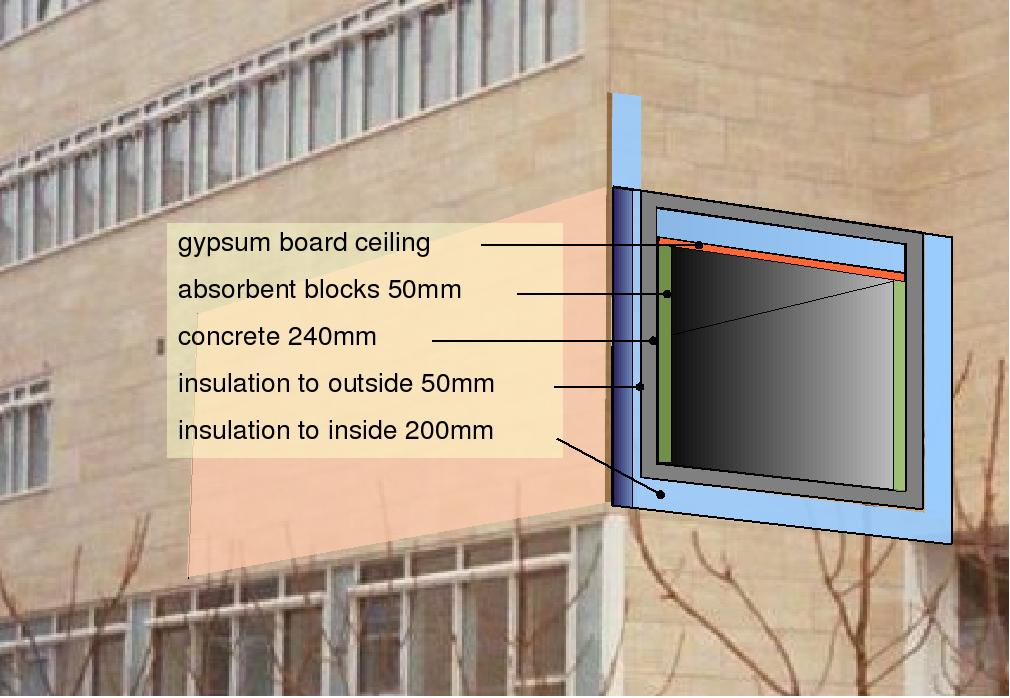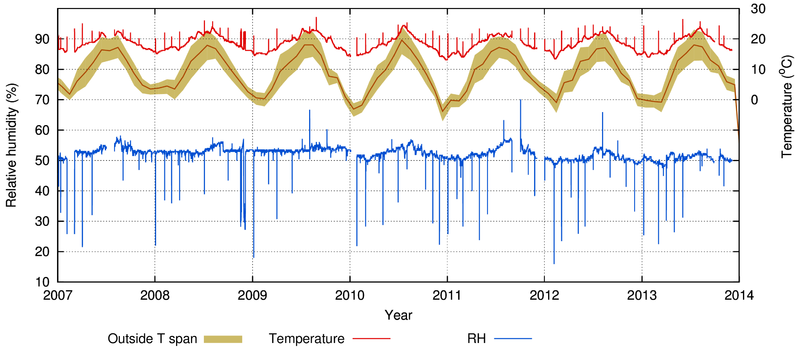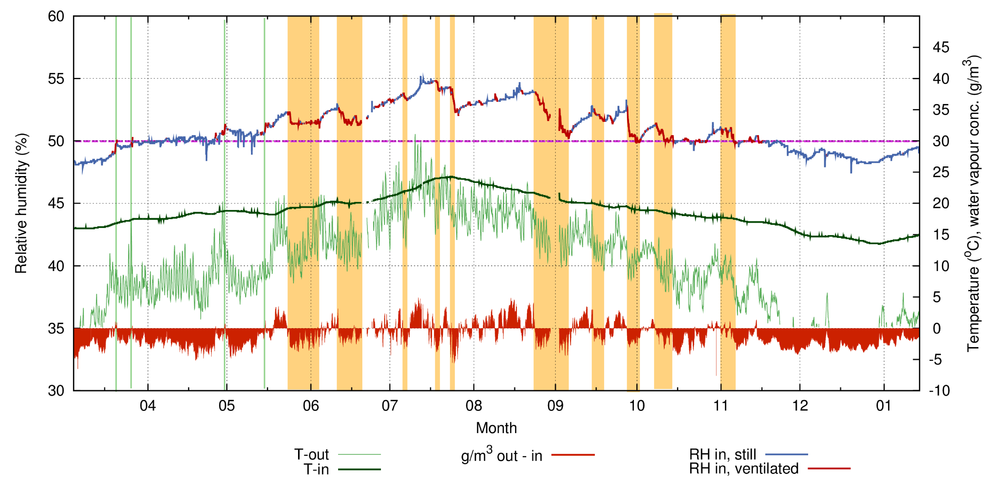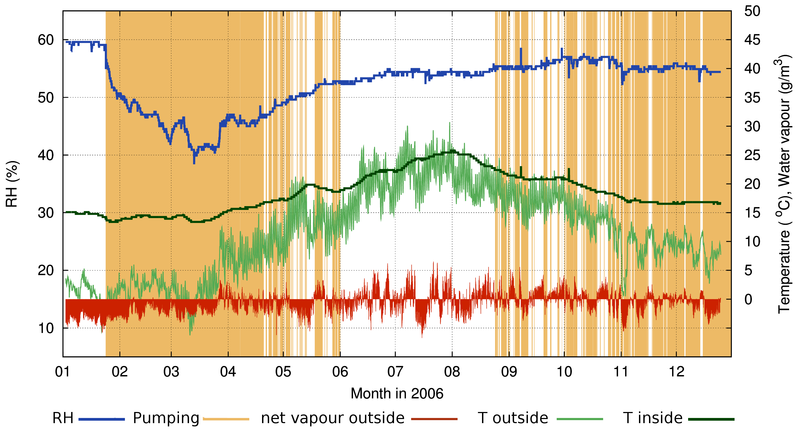
 |
Climate control in the archive of the Arnamagnaean Institute |
This is an expanded version of the article : Tim Padfield, Morten Ryhl-Svendsen,
Poul Klenz Larsen, Mette Jakobsen and Lars Aasbjerv Jensen. 'The climate control of the Arnamagnæan Archive', in: Driscoll, M.J. (ed)
The 16th Care and Conservation of Manuscripts Seminar, April 2016, published 2018, pages 35-46.
The Museum Tusculanum Press, Copenhagen.
ISBN 978-87-635-4620-1 ISSN 1602-1339.
The small archive of the Arnamagnæan Institute is almost passively air conditioned by being placed between a corridor in a permanently warm Copenhagen university building and the outer wall of the building. It is well insulated towards the warmed building and thinly insulated towards the outside, so that its temperature is approximately one third of the way between the building interior temperature and the running average outside temperature. The annual average temperature in the archive is above the annual average outside so that the annual average relative humidity (RH) is automatically lower than that outside: it is about 50%. The day to day RH remains steady over the entire year because of humidity buffering by the walls and by the hygroscopic content of the archive. Fine control of the RH is provided by pumping in outside air when it is, by chance, of the right water vapour content to push the archive RH towards its target 50% RH. The energy consumption by the pump is negligible but there is heat from the usually warmer building interior passing through the archive to the outside, so it does use energy. The RH has remained within the envelope of 48% to 58% over a period of 7 years. The temperature has varied within the range 14°C to 24°C with a gentle annual cycle.
There is a small archive of medieval manuscripts in a building of Copenhagen University (figure 1), which has an unusual climate control. It was designed from the start not to use air conditioning but to rely for relative humidity (RH) control on a combination of humidity buffering by the contents and a few degrees of winter heating by leakage from the permanently warm building which partly surrounds it. The temperature varies through the year, being close to the inside temperature in summer but around a third of the way down from the indoor temperature towards the outdoor temperature in mid-winter. The amplitude of this annual temperature cycle is controlled by the relative thickness of the insulation towards the building interior and towards the outside air. A cut away diagram of the construction is shown in figure 2, the interior is shown in figure 3 and a schematic drawing of the climate control principle is shown in figure 5. This article analyses the measured climatic performance of the archive since 2006.
Figure 1: The building in Copenhagen University which houses the Arnamagnæan Institute. The archive is the room behind the windowless portion of the long facade.
Figure 2: A cut away diagram showing the structure of the archive. The insulation towards the interior of the building is thicker than the insulation on the outer walls.
Figure 3: A view of the interior of the archive. It measures 10 x 4 x 3
m high. The lobby is visible beyond the armoured and insulated door. The duct for pumped outside air is just visible above and to the left of the door.
The structure of the archive is made of reinforced concrete. Outside this is thermal insulation of varying thickness, then a stone veneer. Attached to the inside surface of the walls is a 50 mm layer of 'gasbeton' blocks. This is a porous
calcium-aluminium silicate with a fibrous structure. It is the best
humidity buffer among orthodox construction materials. This is coated
with a single layer of silicate paint, which prevents dusting while
allowing air to diffuse into the blocks. The floor is concrete hardened
with fluosilicate. The ceiling is 4 layers of 13 mm gypsum board with insulation
above. The shelving is hard enamelled steel. The massive concrete walls
were specified for physical rather than climatic security but add useful heat capacity. The door opens to the office
area, so air infiltration is mainly from the building rather than from
the outside.
The relative humidity is controlled by ensuring that the average
temperature within the archive is about eight degrees above the average
outside temperature. This will automatically give an average RH in the archive around
50%.
This is known as 'Conservation Heating'. It is used to keep a moderate
RH in museums and historic buildings closed in winter. The temperature
is above ambient, so that infiltrating air drops in RH as it warms to
the indoor temperature. The temperature is generally below human comfort
temperature in winter.
Figure 4: The principle of conservation heating. The inside temperature
is raised above ambient by an amount which reduces the RH of
infiltrating air from the high outside RH.
This principle applied to the Copenhagen climate is quantified in figure 4. This
diagram assumes that there is good air exchange and no humidity
buffering. The temperature excess inside varies from about 8°C in
midwinter to 5°C in early summer.
However, because the room is nearly airtight and full of humidity
buffering paper and parchment documents,
the archive can cruise over long periods of disequilibrium between inside
and outside water vapour concentration without the RH changing much, so the winter temperature can be higher than the
theoretical ideal value and the summer temperature lower.
The archive temperature excess over ambient is kept low in summer and high in winter by the
balance of heat flow into the archive from the inhabited building, which
surrounds four surfaces of the archive, and the heat flow to the outside
through the two exterior walls. The insulation thickness is calculated
to ensure that the archive temperature is approximately the daytime
temperature of the outside air in summer, decreasing to about fourteen
degrees in winter. Without humidity buffering this would give a low RH
in winter, around 30%, and a high summer RH around 70%. However,
humidity buffering is provided by the archive construction and by the
packaging materials, as well as by the archived items. This humidity
buffering only works if the air infiltration rate is low. In this archive it is about 0.1 air
changes per hour.
Figure 5: A perspective sketch showing how the archive temperature is
set by the competing heat flows through the interior walls and the
exterior walls. The RH is fine-tuned by pumping in air when by chance
the outside air has suitable water vapour content.
Figure 6: A record of the archive climate over the last seven years,
compared with the monthly average outside temperature and the outside
temperature span. The spikes show the climate in the conservator's office when the logger
was retrieved to extract its data.
The generous layout of the archive, with objects packed with plenty of
surrounding air space, led us to provide a mechanical fine control of
the climate to supplement the humidity buffering. It occasionally
happens, particularly in summer, that the outside air has a water vapour
content which, if it is pumped into the archive, will push the interior
RH towards the 50% target. The pump increases the air exchange rate from 0.1 to
about 0.5 per hour. It is activated by the building management computer which makes the following calculation from sensors inside the archive and outside the building:
first, the moisture content of air at the target value 50% RH and at
the current archive temperature is calculated. Then the actual water
vapour content is calculated for both inside and outside air, using
relative humidity and temperature sensors. If the outside air water
vapour content is closer to the target than the inside
concentration, the pump is activated. It passes outside air through a
filter for dust and pollutants and then releases it at the far end of
the room, to exhaust through a vent near the door.
In principle the various concentrations should be calculated as 'mixing
ratio', which is the water vapour mass per unit mass of dry air. This requires knowing the total air pressure so it is easier, and not
significantly inaccurate, to calculate the vapour content in weight per
unit volume. The balance of water vapour content inside and out is shown in figures 7 and 8 as shaded areas above and below the zero line. Shading above the line indicates excess water vapour in the outside air.
The energy used by the pump is negligible but the heat energy moving
through the exterior walls of the archive amounts to about 14 kWh/m3 per
year.
Figure 7: The year 2010 in the archive. The red segments of the RH trace at the top
indicate periods when outside air was pumped in to raise the air
exchange rate from 0.1 per hour to 0.5 per hour. The shaded strips
identify major pumping events and show how they correlate with the
difference in water vapour content between the outside and the archive
air. The dashed horizontal line marks the target RH.
Figure 7 shows the influence of the pumping on the archive RH. Pumping
is rare in winter (pale green background shading), because the
temperature is far above ambient, so the outside water vapour content is nearly
always too low to raise the RH in the archive. The slow change in RH
during the winter is due to buffering by the archive walls and the
archived materials, supplemented by some human generated moisture from
archive visitors and office workers in the building.
In summer, there is such a small temperature excess above ambient that
infiltrating air will usually raise the RH above the set point, towards the
outdoor RH, which is about 70%. However, there are quite frequent
periods when the water vapour content of the outside air is usefully
low, as shown by the shaded areas in figure 7. The pump will then act to
reduce the archive RH. It is very effective at this, as the steep
downward gradient of the red portions of the RH trace reveal. Notice, however,
the rebound after each pumping event. This is partly due to
buffering by the archived materials which 'remember' their earlier,
higher RH. The rebound is also due to periods of unusually high moisture
content in the ambient air, notably in the second week of July in figure
7.
There is very little change in archive temperature during these
episodes. This is partly due to the heat capacity of the solid concrete
walls but also due to the small difference between inside and outside
temperature during the summer.
The stability of the archive climate against prolonged periods of
disequilibrium with the outside air must be maintained by buffering. This was tested
by increasing the winter ventilation, using the pump continuously. The
summer performance was tested by stopping the pump, so that the RH was
influenced by natural infiltration only.
Figure 8: The effect of ventilation on the humidity buffering of the
archive. From late January to mid March the ventilation was run
continuously at 0.5 air changes per hour. From July to late August the
ventilation was stopped.
Figure 8 shows the result of this sensitivity test, where the
ventilation was first run continuously during the winter, when its
effects would be mostly bad - reducing the RH because of the low
moisture content of the outside air reacting to the relative warmth of
the archive. In summer, the ventilation was stopped, in a period of
generally high external water vapour content which would tend to
increase the inside RH.
The RH dropped fairly quickly in winter, when the ventilation was 0.5
air changes per hour, falling 10% in the first week and another 10% in
the next month. This would not be catastrophic but it indicates that the
air exchange rate overwhelmed the buffer capacity of the archive. The
inside RH picked up again in late March with a sudden rise in ambient
temperature. The winter dip in the RH from 60% to 40% RH would be
acceptable in many museum collections of robust materials, but is
certainly not ideal.
The summer RH increased in mid June but then stabilised from July
onwards because the inside temperature rose above the ambient average,
while the summer ambient RH is relatively low. It seemed that the
moisture sensitive ventilation system might not be necessary. When normal
operation resumed from late August, the RH became more irregular, though
remaining within a 5% band of RH. In some years, however, the forced ventilation has definitely improved the RH stability in summer.
Figure 9: The conservation heating performance of the Arnamagnæ an
archive over the year 2010. The dark green line is the inside RH, the limit
of the pale green fringe marks the theoretical RH of outside air brought
in and warmed, or occasionally cooled, to the inside temperature, which
is the red line. The outside temperature is the limit of the pink
fringe. The winter temperature is much higher than the theoretical value
required for sustaining the 50% RH target. In summer the
archive temperature is not sufficiently above ambient to prevent
the RH rising above the target. Nevertheless, the archive RH remains
almost constant, with just a slight increase in midsummer.
Figure 9 compares the measured RH with the expected RH, assuming no buffering. The theoretical RH for an unbuffered,
ventilated room at the actual temperature of the archive drops down in
winter but is not matched by a comparable rise in summer. There appears
to be a permanent excess of water vapour within the archive. However,
this can not be confirmed by this diagram, because it shows the relative
humidity, which is a potential, not a concentration. To investigate this
mystery, we have to look at the mixing ratio of the inside and outside
air masses.
Figure 10: The mixing ratio of the air outside and inside the archive.
The mixing ratio is the weight of water vapour mixed with unit weight of
dry air. The mixing ratio does not change on infiltration, as the RH
does, because as the air expands into the warmer archive, the ratio of
water vapour molecules to air molecules remains the same.
Over the full year, the average mixing ratio inside should be the same
as outside, otherwise, there must be an independent addition of water to
the inside air. This seems to be the case. The outside to inside mixing
ratios were 44:56. This is the ratio of areas under the curves in figure
10. The most significant infiltration is from the corridor and from the
adjacent office. Also, workers within the archive will add water vapour
directly (see figure 11).
An unventilated room will accumulate carbon dioxide from people within
it. The archive is active, but not busy. Items are fetched for study in
the adjacent reading room. The spikes of carbon dioxide are detectable,
and the concentration is continuously monitored for both safety of
people and security against unauthorised entry.
Figure 11: The carbon dioxide concentration in the archive is
superimposed on the periods of ventilation, marked by orange stripes. Notice that the CO2
concentration falls below ambient during unventilated periods (white
background), probably due to absorption into building materials. The RH
trace shows a small increase in RH coinciding with the CO2 peaks
during periods without ventilation. Both CO2 and water vapour are produced by people in the archive.
Figure 11 shows sharp spikes in CO2 when staff enter the archive.
Typically there is one visit per day, which usually only raises the
concentration to 600 ppm, which is regarded as acceptable. The limit for
permanently occupied spaces is generally put at 1000 ppm, depending on
the local building regulations. The RH also rises briefly but is
buffered by sorption into the archive materials.
A curious feature of figure 11 is that the CO2 concentration drops
below ambient when the ventilation is stopped. This is surely caused by
reaction with the immature building materials, though the archive was
completed in 2002 and brought into use in 2004.
Pollution from outside is intercepted by a carbon filter in the pumping
system. Pollution generated internally, principally acetic acid vapour,
is absorbed by recirculation through the same carbon filter.
At the time the archive was designed, the dominant, internationally
influential standard for archives was British Standard BS5454:2000. The
temperature specification was very strict: choose a temperature between
16°C and 19°C, then apply a variation limit of ±1°C to that temperature. The RH
specification was 35% to 60%, with a ±5% range around the chosen constant target. The archive nearly achieves the RH standard. The merits of
the temperature standard have been discussed elsewhere (Padfield 2008,
Ryhl-Svendsen et al 2010). After the archive was completed and put to
use, the standard was relaxed considerably, but not enough to
retro-regularise this archive. PD5454:2012 allows a temperature span
from 13°C to 20°C for sensitive collections. The archive temperature
exceeds this upper limit for nearly a quarter of the time. The maximum
temperature in 2010 was 24.3°C. The effect on chemical degradation rate
is approximately compensated by the lower winter temperature - the same
fraction of the time is below 16.8°C. The minimum temperature was
13.5°C. The span of the annual cycle is typically eleven degrees.
The 20°C upper limit advised by PD5454 has no particular significance for
chemical or physical stability of artifacts, yet it is already used as a
firm specification. Aristotle (350 BC) stated that the precision
required for a concept should be appropriate to its nature. There is no
catastrophic result of exceeding 20°C so one should follow the normal
building engineers practice of specifying a temperature that can be
achieved while the local weather is within its normal range while
accepting that the outside temperature will be unusually high for short
periods. For northern Europe, a reasonable design target for passive
climate control of archives would be 25°C. This is achievable without
mechanical aid whereas 20°C is not easily achieved. Such a limit is advocated in the joint declaration of the International Institute for Conservation (IIC 2014) and the conservation committee of the International Council of Museums, which endorses previously existing guidelines which set temperature limits at 16°C - 25°C (BIZOT) and 15°C - 25°C (AICCM & AIC). There are no reasons or references given for the lower limit, or for the upper limit. Whatever the reason, it is good to have retrospective endorsement of the climate in the Arnamagnæan archive.

The construction materials
The climate control principle


Resilience of the humidity control

Comparison of measured with theoretical performance
Air pollution
Conformity with standards
Conclusions
The archive has performed well in providing a moderate climate. The RH has remained within 6% of 50% for the last seven years. This good performance is not entirely attributable to the cunning design. The winter temperature is higher than it should be theoretically but works because the infiltrating air has been humidified by human activity within the building. The weather dependent pumping of outside air has contributed largely to keeping the RH down during the vulnerable summer period when the archive temperature is too close to ambient to keep the RH close to 50% and there is still a human contribution to the water vapour content of infiltrating air. In retrospect, there should be better sealing of the door against infiltration of office air. Summer visits should be kept brief, to minimise vapour injection by people within the archive.
Temperature variation in archives has hitherto been discouraged by stringent standards but the approximately ten degree annual span, without sudden changes, presents no scientifically documented danger to the collection. The 14°C minimum in winter presents a small danger of transiently high RH at the object surface when it is taken out, depending on the temperature and RH of the reading room. However, a brief acclimatisation in an airtight insulated bag will entirely eliminate this risk. The summer temperature rises above the arbitrary 20°C limit advised for sensitive collection in the recently published PD5454:2012 from the British Standards Institution. We suggest that a fixed upper limit should be replaced by a 'design limit' which may only be exceeded for a small number of days in the year. Strict adherence to an upper limit that has no documented consequences if it is briefly exceeded will force mechanical cooling, which in turn forces dehumidification, in other words full air conditioning.
This principle of running the archive with a temperature cycle which rises to about the same as outside during the summer but remains much warmer than ambient in winter has also been applied to free-standing archives. In this case it is necessary to maintain a minimum temperature around 14°C in winter, depending on the local climate. Only thermostat control is necessary, the buffering by the archived material will automatically ensure a stable and moderate RH throughout the year (Padfield 2008).
This archive is small and unusually situated at the edge of a larger building. Nevertheless, the same climate control principle can be applied on a larger scale and in a different architectural setting. A systematic treatment of the physics of low energy climate control in archives and museum storage is given in (Padfield et al 2013).
We thank Peter Springborg, former director of the Arnamagnæan Institute, for accepting an unusual climate control proposal. The calculation to optimise the insulation thicknesses was by Jens Eg Rahbek of Cowi consulting engineers, Lyngby, Denmark. The architect was KHRAS, Lyngby.
A simpler and more explanatory version of this article will be published in the proceedings of the 16th seminar on the care and conservation of manuscripts, held at the University of Copenhagen, Faculty of Humanities 13 - 15 April 2016.
Other examples of the deliberate use of a moderate annual temperature
cycle in reducing the cost and complexity of climate control are
presented in:
Tim Padfield, Poul Klenz Larsen, Morten Ryhl-Svendsen
and Lars Aasbjerg Jensen (2013) 'Low energy museum storage' (in press).
Papers delivered at the Paris conference of the Centre de Recherche sur la Conservation des Collections, October 2013.
www.conservationphysics.org/storage/low-energy-museum-storage.php
Morten Ryhl-Svendsen, Lars Aasbjerg Jensen, Poul Klenz Larsen and Tim
Padfield (2010). 'Does a standard temperature need to be constant?' -
Paper delivered at the Going Green conference at the British Museum,
April 2009. Published in Meddelelser om konservering nr 1, 2010 pp13-20.
www.conservationphysics.org/standards/standardtemperature.php
Tim Padfield (2008). 'Simple climate control in archives is hindered by
too strict standards'. Proceedings of the 8th Symposium on Building
Physics in the Nordic Countries. Department of Civil Engineering,
Technical University of Denmark, (2008) pp 1429-1436 ISBN
978-87-7877-265-7.
www.conservationphysics.org/ppubs/simple_archives.pdf
Aristotle (350 BC), Nicomachean Ethics. Book 1, Chapter 3.
There are various translations. One is "Our treatment of this science
will be adequate, if it achieves that amount of precision which belongs
to its subject matter."
IIC (2014). 'IIC announces declaration on Environmental Guidelines', https://www.iiconservation.org/node/5168 (accessed at 2014-10-05).
© the authors, 2014

This work is licensed under a Creative Commons Attribution-Noncommercial-No Derivative Works 3.0 License.